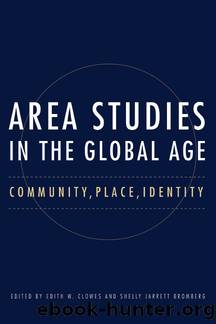Area Studies in the Global Age by Unknown

Author:Unknown
Language: eng
Format: epub
Publisher: Northern Illinois University Press
Published: 2015-02-13T00:00:00+00:00
Rebirth of Political Islam in Central Asia
The spread of fundamentalist ideas in parts of Central Asia precipitated the emergence of Islamist groups and movements in these states. The origins of the Islamist groups can be traced to underground mosques and informal religious schools that operated in Uzbekistan and parts of Tajikistan in the late 1960s and 1970s. The educational efforts of unofficial mullahs teaching in the clandestine religious circles gave rise to a new generation of modern Muslim theologians. Two Islamic teachersâMuhammad Rustamov Hindustoni (1892â1989) and Abdulhakim Qori (b. 1896)âstand out, in particular, for training and inspiring numerous Muslim activists who played an indispensable role in the Islamic rebirth in Central Asia.33 Said Adbullo Nuri, one of the founders of Tajikistanâs Islamic Renaissance Party (IRP), was a student of Hindustoni, while Juma Namangani, the leader of the Islamic Movement of Uzbekistan (IMU), studied with Abdulhakim Qori.34
Because of the many obstacles to the establishment of national and region-wide Islamic organizations, smaller and locally operated Islamist movements and groups became the primary form of organization of Islamic activism in Central Asian states. In 1991, the famous Adolat (Justice) groups appeared in Uzbekistan. They marked a synthesis of the local self-government, militia, and clergy. The militia units were directed to keep order in the streets; the local authorities provided material assistance to the poor and enforced zakat (charitable contributions); and the clergy engaged in religious propaganda.35 Ideologically, Adolat groups were Salafi. Their religious leadership preached Islamic puritanism and advocated the establishment of an Islamic state deemed as the only solution to crime, poverty, moral degradation, and many other socioeconomic concerns. In the early 1990s, a radical wing of the âwarriors of Islam,â or Islom Lashkarlari, crystallized within Adolat. The âwarriorsâ committed themselves to jihad, the violent struggle against a secular regime in Uzbekistan, in the name of Islam. By 1991, Adolat assumed political control of the city of Namangan by taking over the Communist Party building and establishing a shadow government. These actions prompted a backlash from the secular government of President Karimov in Uzbekistan. Several prominent members of Adolat were arrested and the group was disbanded by the state. Its leaders found refuge in Tajikistan, where they took part in the Tajik civil war and created a new Islamist organization, the Islamic Movement of Uzbekistan (IMU), around 1997.36
The IMU retained some characteristics of a conservative Salafi organization inherited from Adolat. Because its leadership had a weak theoretical background in Islam and considerable fighting experience, the IMU developed into a jihadist organization with a vague political agenda limited to toppling the Karimov regime in Uzbekistan and imposing strict observance of Islamic norms and prohibitions in this country.37 The United States, Russia, China, Central Asian states, and other states designated the IMU as a terrorist organization because of a series of terrorist attacks in Uzbekistan, raids on Kyrgyzstan, and ties with the Al Qaeda and Taliban networks. Severely weakened in combat with the United Statesâ and its alliesâ forces in Afghanistan, the IMU lost
Download
This site does not store any files on its server. We only index and link to content provided by other sites. Please contact the content providers to delete copyright contents if any and email us, we'll remove relevant links or contents immediately.
| Africa | Americas |
| Arctic & Antarctica | Asia |
| Australia & Oceania | Europe |
| Middle East | Russia |
| United States | World |
| Ancient Civilizations | Military |
| Historical Study & Educational Resources |
Cat's cradle by Kurt Vonnegut(15238)
Pimp by Iceberg Slim(14429)
4 3 2 1: A Novel by Paul Auster(12320)
Underground: A Human History of the Worlds Beneath Our Feet by Will Hunt(12048)
The Radium Girls by Kate Moore(11962)
Wiseguy by Nicholas Pileggi(5698)
The Fire Next Time by James Baldwin(5361)
Perfect Rhythm by Jae(5349)
American History Stories, Volume III (Yesterday's Classics) by Pratt Mara L(5271)
Paper Towns by Green John(5121)
Pale Blue Dot by Carl Sagan(4942)
A Higher Loyalty: Truth, Lies, and Leadership by James Comey(4899)
The Mayflower and the Pilgrims' New World by Nathaniel Philbrick(4449)
The Doomsday Machine by Daniel Ellsberg(4439)
Killers of the Flower Moon: The Osage Murders and the Birth of the FBI by David Grann(4403)
The Sympathizer by Viet Thanh Nguyen(4332)
Too Much and Not the Mood by Durga Chew-Bose(4295)
The Borden Murders by Sarah Miller(4267)
Sticky Fingers by Joe Hagan(4138)
